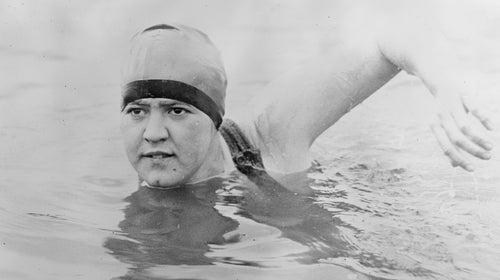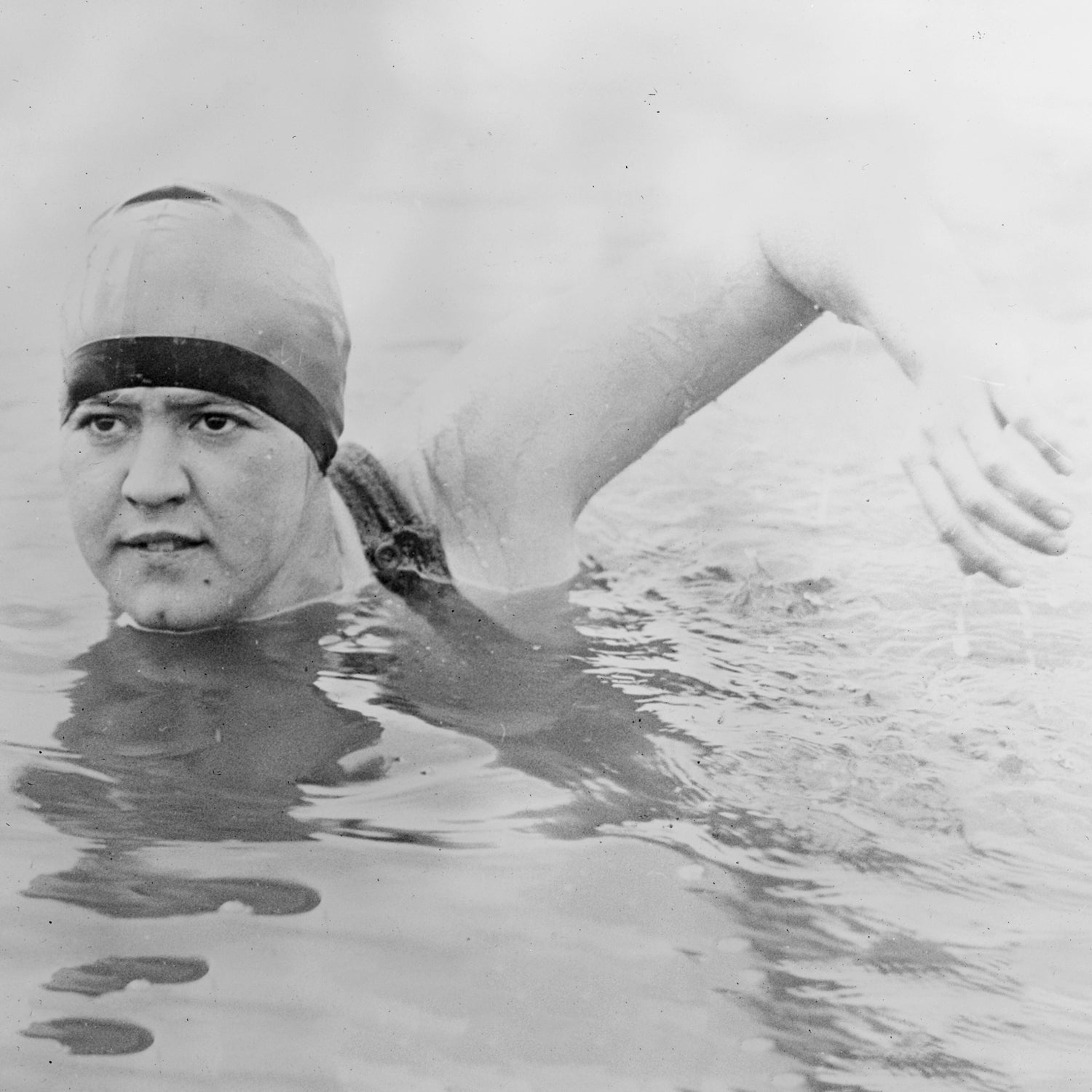Gertrude Ederle wore three layers of grease, a pair of amber-tinted goggles, and a scandalous two-piece swimsuit when she waded into the 60-degree waters of the on August 6, 1926. It was her second attempt to swim the infamous 21-mile stretch of sea between France and England—a feat no woman had ever completed. This time, she figured she would either succeed or die trying.
The weather was calm that morning, but as Ederle, a champion swimmer and Olympic medalist from New York City, plowed through the water at about two miles per hour, the sky darkened and conditions deteriorated. More than halfway across the strait, the seas became so choppy that the captain of her support boat started to get nervous for his vessel. The wind screamed at more than 20 knots, the swells crested at six feet, and a consistent rain hurled down. Even the photographers stopped their clicking and instead cowered in the pilothouse.
Finally someone—no one knows who—shouted at Ederle from the boat’s railing that it was time to get out of the violent sea. Ederle, just 19 years old at the time, had been oblivious to the hysteria on the vessel. She was happily riding the waves up and gliding back down, singing popular tunes in her head. She looked at the ship, perplexed. Get out of the water? Are you crazy?
“What for?” she yelled back, calmly and surely. The crowd cheered. She smiled, put her face back in the water, and carried on.
Gertrude Ederle’s Beginnings
Gertrude Ederle had surprised competitors and spectators right from the start of her storied career as one of the 20th century’s best athletes, male or female. In her first major race, the Day Cup, a 3.5-mile international women’s race between Manhattan Beach and Brighton Beach, she entered as a complete unknown and beat the reigning American and European champions. She was 15.
At the time, women and girls weren’t commonly taught to swim, and women’s swim leagues were in their infancy. Ederle was lucky enough to be the daughter of a successful German butcher in New York who bought a vacation home on the New Jersey shore, where he encouraged his daughters to swim. She loved it. Since the age of five, young Trudy had suffered a hearing impairment from a bout of the measles. The disability had made her feel socially awkward, and she often retreated into her own world and read voraciously. But in the water, Ederle found solace.
“To me, the sea is like a person—like a child that I’ve known a long time,” Ederle said decades later. “It sounds crazy, I know, but when I swim in the sea, I talk to it. I never feel alone when I’m out there.”
At the time, the public perception was that women simply weren’t capable of swimming the English Channel.
Unlike many of the women swimmers at the time, who trained in pools, Ederle developed unusual strength and stamina from playing in the ocean all day. She was also blessed with a stout, broad-shouldered physique that gave her an edge as she employed a fast new stroke known as the crawl. Soon after her competitive debut in 1922, Ederle dominated the nascent spectator sport. The drama of her first win helped bring out thousands of spectators to these amateur women’s races, as Ederle shattered nearly 30 records in a matter of four years.
“She basically held world records from 25 yards and up, and that’s just absolutely extraordinary,” says sportswriter Glenn Stout, author of . “That would be like Usain Bolt winning marathons.”
The World of Women’s Swimming
In 1924, as a teenage prodigy, Ederle traveled to Paris for the Olympic Games, winning a gold and two bronze medals. Sorely disappointed by that showing, she set her sights on an even more audacious goal.
At the time, the public perception was that women simply weren’t capable of swimming the English Channel. The weather was too volatile, the distance too long, and the tides merciless. Besides, only five men had ever accomplished the feat, and there’d been dozens of failed attempts.
On her first try, in 1925, Ederle made it much of the way across, but her trainer—Jabez Wolffe, a feisty and arrogant Scotsman—ordered her to be pulled from the water because he thought she looked sick. Ederle believed he had poisoned her tea because he secretly didn’t want her to make it. (If true, it was perhaps out of jealousy—Wolffe had tried and failed to swim the channel more than 20 times.) After that failed attempt, however, many believed that if Gertrude Ederle couldn’t make the swim, no woman could.
About a year later, in a silk swimsuit she designed herself, Ederle set off, motivated to prove the naysayers wrong—and to win the sleek red sports car that her father had promised her if she succeeded. She braved the threat of sharks and jellyfish, a tongue swollen from the salt, and a punishing storm, while reporters followed in a boat and wired updates on her progress. As Ederle neared the English shore and darkness fell, people tuned in to their radios, collected in pubs, and gathered on the beaches, lighting bonfires and honking their horns to guide her in.
Crushing the Men’s English Channel Records
Fourteen hours and 31 minutes after leaving France, Ederle stumbled onto shore to ballooning crowds—the first woman to swim the English Channel. Despite the foul conditions, she had done it nearly two hours faster than any of the five men before her.
“I think you can make the case that it was the singular achievement that did away with the argument forever that women cannot compete as athletes,” says Stout. “Trudy hadn’t just conquered the Channel, a remarkable achievement in itself for a woman, but she had beaten—make that shattered—the men’s record, and by such an enormous margin that it caused a complete recasting of perceptions,” he writes in Young Woman and the Sea. “The phrase ‘weaker sex’ suddenly sounded old-fashioned.”
News of Ederle’s victory spread across Europe and North America. Job offers, invitations to fancy events, and even marriage proposals poured in. When she arrived in New York City three weeks later, a flotilla of vessels came to greet her ship and planes circled overhead dropping flowers upon her. A few hours later, hundreds of thousands of people turned out to greet Ederle in a ticker-tape parade. Women soon began to participate in more sporting events and become professional athletes, a phenomenon historians credit partly to Ederle’s groundbreaking swim and ensuing celebrity.
“That she broke a record that men had set was different and important,” says Susan Cahn, a history professor at SUNY Buffalo and author of . “There was a lot of popular enthusiasm, but it also made people nervous—people who wanted to protect the gender system as it was.” At the time, women had just won the right to vote and were starting to join the workforce in higher numbers.
Despite the foul conditions, Ederle had done it nearly two hours faster than any of the five men before her.
Ederle, a quiet, introspective young woman, was overwhelmed by all the attention—so overwhelmed that she soon suffered a nervous breakdown. After she recovered, she capitalized on her fame by performing in a vaudeville-like show with a large tank and two other champion swimmers. But Ederle no longer competed, as if she had simply accomplished what she had set out to do.
In the 1930s, Ederle suffered a debilitating back injury from a fall down a stairwell. Her hearing also worsened over time—perhaps a result of the channel swim—making her withdraw into herself even more. She chose to remain single and led a quiet life doting on her nieces and nephews and teaching deaf children to swim. She at the age of 98.
In interviews from her later years, Ederle expresses a general contentment with her life as it was. After all, she didn’t swim for the attention.
“I just did the best I could, and I never thought of winning,” Ederle told a reporter after that first sensational win at the Day Cup in 1922. “I guess I swim as easily as I breathe or walk. And I truly think it ought to be just as natural for everybody. The scientists say we were all water animals to begin with, then why shouldn’t we go back, now and then, to our first home—the ocean?”


